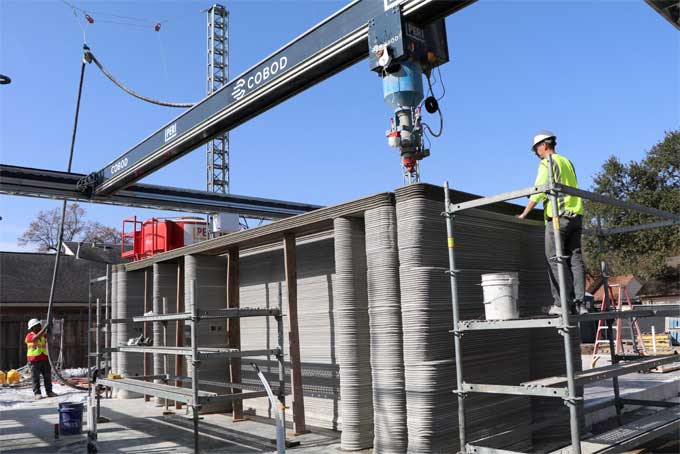
Use of 3D Printing in the field of Construction

The construction sector has been revolutionised by 3D printing in recent years. As a result of 3D printing, the construction industry has entered a new era of almost unlimited design possibilities. Architects, designers, and builders use 3D printing for everything from large multi-story buildings to bridges.
The construction industry's use of 3D printing
Construction industries such as housing, bridges, and more have benefited greatly from the use of 3D printing technology. There are a number of advantages of 3D printing for construction, including the potential for cost savings and faster production.
Besides creating intricate parts, 3D printing is also used to develop internal piping and ventilation systems. Using this technology, builders can construct internal buildings more quickly and efficiently than they did in the past.
The use of 3D printing also allows for the creation of complex scaffolding that would have been difficult and time consuming to create with traditional methods. In the subsequent steps of the construction process, this scaffolding will be used to support the other steps. A strong support structure is particularly useful in high-rise buildings and complex constructions.
When it comes to construction, 3D printing technology is evidently a game-changer. By using this method, you can save money, speed up production, and improve accuracy over traditional construction methods. Additionally, scaffolding and models can be created before construction begins. Construction is sure to undergo a revolution as 3D printing becomes more widely used.
Design and Architecture
The rise of 3D printing is transforming architecture and design in unprecedented ways. A building's infrastructure and appearance have been mapped out by architects and structural engineers for centuries by hand. Buildings and other structures can now be constructed faster, more efficiently, and more cost-effectively thanks to 3D printing technology.
Compared to traditional building processes, 3D printing offers a number of advantages. The first advantage of 3D printing is its speed, which eliminates the need for long-term design and construction processes. Furthermore, 3D printing allows for more detailed designs, which allows for greater creativity and innovation when designing buildings and other structures.
The cost of 3D printing structures is also much lower than traditional construction methods. As a final benefit of 3D printing, construction waste is reduced, reducing the environmental impact of building construction.
Architecture and design can benefit greatly from 3D printing technology. In traditional construction methods, it would have been impossible to create curved walls, complex designs, and other innovative features. Construction and design are likely to become staples of the industry as 3D printing continues to develop.
Engineers, architects, and designers can use 3D printing technology to create more cost-effective, efficient, and aesthetically pleasing structures, revolutionizing the way things are built and designed in the future.
Merits of 3D Printing in Construction
There are many merits of using 3D printing in the field of construction, some of these merits are as follows:
1. Environmentally friendly: Compared to conventional building techniques, 3D printing is significantly more ecologically friendly. Up to 99% less material may be used, which leads to considerably fewer emissions of dangerous air and water contaminants. Also, as components are produced utilising 3D printing rather than dangerous chemicals, less energy and water are utilised in manufacturing.
2. Time-saving: A substantially shorter building period is possible thanks to 3D printing's superior speed and efficiency compared to conventional construction techniques. The time-consuming setup procedures and costly tooling required for conventional manufacturing techniques may be avoided by using 3D printing to make components fast and precisely. Additionally, sophisticated components that were previously difficult or impossible to fabricate may now be created via 3D printing.
3. Economical: By removing the requirement for personnel and other resources connected with conventional construction methods, 3D printing significantly reduces the cost of construction. Components that are 3D printed may be manufactured rapidly, accurately, and with little waste. Moreover, because 3D printing may be done on-site, shipping expenses can be significantly decreased or even eliminated.
Issues of 3D printing in Construction
The process of ideation and planning is one of the main difficulties with 3D printing in building. Before beginning the 3D printing process, it is crucial to have a thorough understanding of the project and the dangers involved because the technology is still relatively new. Understanding the materials used, the printing technique' limits, and any potential legal or structural restrictions are all part of this.
Budget restrictions are another barrier to 3D printing in the building industry. Even the most basic 3D printer may be pricey since the cost of 3D printing materials and equipment is still high. Larger projects might be expensive since there are additional costs for the software and the time needed for design and printing.
Another difficulty is ensuring that those using 3D printing are safe. Due to the technology's youth, there are not many regulations or legislation in place to protect workers' safety and the general public's. Moreover, additional planning and supervision are needed due to the scale and complexity of 3D-printed buildings to guarantee the project is completed successfully and without danger.
To learn more, watch the following video tutorial.
Video Source: Apis Cor
Last but not least, the scale of 3D printing in construction remains limited. Large structures can be constructed with this technology, but the available machinery and software limit their size and complexity. 3D-printed structures will likely become more complex and larger as technology develops, but this is still a challenge for now.
Final Thoughts
It has become increasingly important to use 3D printing in the construction industry since it saves time, money, and the environment. The process of construction has the potential to undergo a complete revolution with 3D printing's ability to produce components quickly and accurately.
To ensure any project's success, from budget and concept to safety and scale, it is important to understand the challenges associated with the technology.


